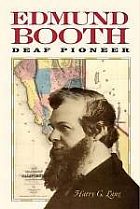|
|
|
Edmund Booth, early Jones county pioneer, lost his hearing and part of his sight due to a childhood illness, but went on to become a founder of Anamosa, editor of the Anamosa Eureka for forty years and participant in the California Gold Rush. Both he and his wife, Mary Ann Walworth Booth, were totally deaf, both of them having lost their hearing on account of childhood diseases. (Theirs was the first marriage recorded in Jones County.) Edmund did not fully lose his hearing until he was about eight years old, so he retained some speech. Given his total deafness after the age of eight, his adult powers of speech were considered remarkable. But, Mary Ann communicated only through Sign and through written English.
 Edmund went as a Forty-Niner to California to "strike it rich" in the goldfields, leaving Mary
Ann and two young children at home in Anamosa for almost five years. He did not become a millionaire (worse luck!); but he did find enough gold to send money back to Mary Ann. She invested in land, had a house built, and generally took the kind of responsibilities that were beyond the experience of many women--even hearing women--of her day. Edmund went as a Forty-Niner to California to "strike it rich" in the goldfields, leaving Mary
Ann and two young children at home in Anamosa for almost five years. He did not become a millionaire (worse luck!); but he did find enough gold to send money back to Mary Ann. She invested in land, had a house built, and generally took the kind of responsibilities that were beyond the experience of many women--even hearing women--of her day.
 She bought what has become prime real estate in downtown Anamosa. You can find the Booth Tract on city maps, bounded by Main, Booth, First, and Fourth Streets. It was part of this land that Edmund donated for the Library. He also donated the land for the first site of the Congregational Church--then on Main Street--although that site later was exchanged for a larger one at
the corner of Booth and First Streets. She bought what has become prime real estate in downtown Anamosa. You can find the Booth Tract on city maps, bounded by Main, Booth, First, and Fourth Streets. It was part of this land that Edmund donated for the Library. He also donated the land for the first site of the Congregational Church--then on Main Street--although that site later was exchanged for a larger one at
the corner of Booth and First Streets.
 Shortly after Edmund returned from California, he bought the city newspaper, the Anamosa Eureka, of which he was the editor from 1858 until his retirement in 1898. His son, Thomas, worked alongside his father, and after his father's retirement, served as editor of the paper until be retired in 1911. Shortly after Edmund returned from California, he bought the city newspaper, the Anamosa Eureka, of which he was the editor from 1858 until his retirement in 1898. His son, Thomas, worked alongside his father, and after his father's retirement, served as editor of the paper until be retired in 1911.
 You can read more about Edmund and Mary Ann Booth at the Library of Congress American Memories site, including his diary and letters chronicling his overland crossing; prospecting at Feather River, Hangtown, and Sonora; visits to Sacramento, Columa, Columbia, and Stockton; and return voyage via Nicaragua, 1854. You can read more about Edmund and Mary Ann Booth at the Library of Congress American Memories site, including his diary and letters chronicling his overland crossing; prospecting at Feather River, Hangtown, and Sonora; visits to Sacramento, Columa, Columbia, and Stockton; and return voyage via Nicaragua, 1854.
Submitted by: Wilma Spice second-great-granddaughter of Edmund Booth.
|
|
 |
| A biography of one of Jones county's most famous citizens, Edmund Booth: Deaf Pioneer, has been published by Gallaudet University Press. Booth fit perfectly the mold of the ingenious pioneer of 19th-century America, except for one difference—he was deaf. |
| See his OBITUARY
| |





